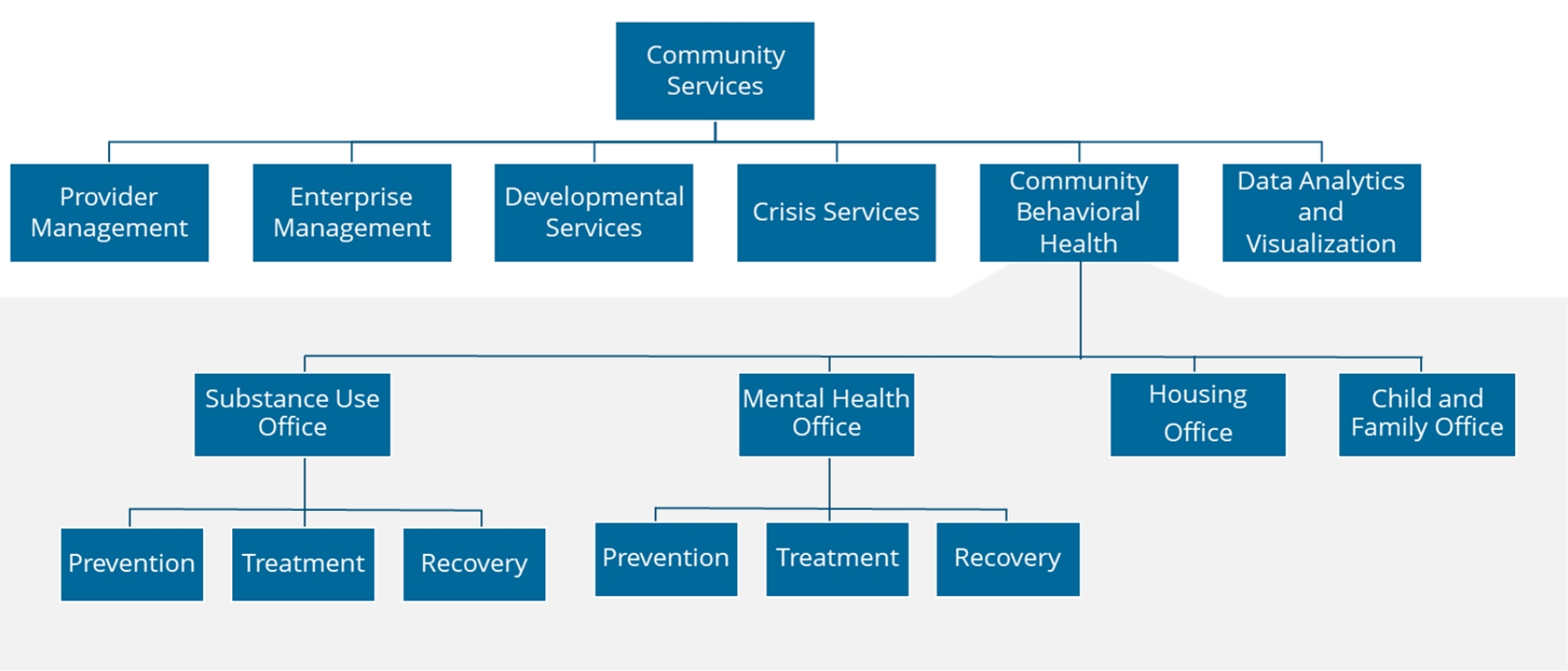Division Reorganization
In May 2025, DBHDS announced changes to the Community Services Division to better support Virginians with mental illness and substance use disorders. This reorganization is part of a multi-year effort that affects every division across DBHDS to modernize operations and ensure better outcomes for the people DBHDS serves.
Structural Changes
Currently, the Office of Recovery Services (ORS) and the Office of Behavioral Health Wellness (OBHW) and prevention are housed in siloed, standalone offices. There is a clear need to ensure the concepts of recovery and prevention are woven throughout community services. As a result, DBHDS is working to integrate these offices into the larger offices of adult mental health and substance use services. These actions will better support service delivery across the continuum of care and elevate recovery and prevention in all of our programs and services.
No services will be reduced, no service disruptions will occur for individuals, and no changes will be made to community funding or support as a result of this change.
How This Change Benefits Individuals, the Community, and the System
Embeds Recovery and Prevention in Decision-Making
Recovery and prevention need to be central to every policy, program, and funding decision we make.
Streamlines Operations and Budgeting
DBHDS is modernizing how this division manages resources by bringing related programs under coordinated leadership to maximize impact and outcomes and free up resources and time to invest back into direct services and community supports.
Reduces Operational Silos
More integration of Prevention and Recovery can foster cross-division collaboration, ensuring every initiative benefits from recovery- and prevention-oriented perspectives.
Improves Communication and Systemwide Consistency
Integrating these efforts ensures policies move fluidly across the division, enables better-coordinated services, and allows DBHDS to better share data, identify trends, and respond to challenges.
Develops Long-Term Benefits for the Community
Recovery and prevention programs will have a direct line to adult services leadership, ensuring these strategies are part of the continuum of care, and leading to a system that feels more connected, responsive, and person-centered.
Better Positions DBHDS for Uncertainty in Federal Grant Funding
Integrating recovery and prevention into the core of DBHDS operations positions these essential services to be part of baseline agency operations, reducing vulnerability to uncertainty.
Helps Division Meet Heightened Demands
By integrating prevention and recovery efforts within Adult Behavioral Health and Substance Use Disorder Services, DBHDS can better optimize the whole divisional workforce and expertise. Prevention and recovery principles must be embedded into major activities such as STEP-VA, behavioral health redesign, quality improvement / assurance, and more.
An organizational chart of the behavioral health area of the Community Services is shown below

Data Analytics and Visualization
DBHDS is creating an office focused on data, analytics and data visualization at the Community Services Division level to integrate all data analysts across Community Services and support DBHDS in harnessing data and understanding outcomes.
Implementation and Ongoing Feedback
Importantly, there are aspects of the changes in this division that are still being determined. DBHDS is committed to involving staff and stakeholder input to better inform these changes. The plan to implement these changes should be completed over the summer with implementation complete in the fall.
DBHDS is now in the process of engaging staff and the community in the development and implementation of these changes. We are committed to a transparent, collaborative process moving forward and welcome ongoing dialogue to ensure the community’s priorities are upheld.
In addition to continuous updates to this webpage as a source of information, DBHDS will be forming a Community Services Advisory Workgroup, and offering multiple feedback opportunities, such as lunch and learns, listening sessions, and an email channel so the community can directly shape how integration occurs operationally.
Frequently Asked Questions
Why is DBHDS integrating the Office of Recovery Services (ORS) and the Office of Behavioral Health Wellness (OBHW) into other offices?
Are any positions being cut or services reduced?
What happens to the roles within ORS and OBHW?
Will the individuals who engage in peer and recovery services notice a difference in services?
Will there be changes in how DBHDS works with CSBs to support recovery as well as prevention services?
How will the recovery and prevention communities have a voice in this transition?
Why wasn’t the recovery community consulted before the initial announcement?
How will DBHDS ensure recovery and prevention remain priorities?
What is the focus and end goal of DBHDS’ Community Services division?
Contact Us
Please reach out with any questions or concerns. Emails will receive full consideration from DBHDS






